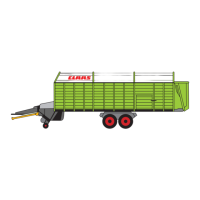TIC QUANTUM Hydraulics
10/04 11-13
Downstroking of the LS pump is performed under the following
conditions:
• a control unit is set to the neutral position. No volume flow is
required.
• an additional control unit is set to the fine control range. A smaller
volume flow is required.
• in parallel operation, a control unit is actuated to the neutral
position or to the fine control range. A smaller volume flow is
required.
The pump must perform a downstroke whenever a smaller volume flow is
needed.
This will always happen when the pressure on the right face end of the
volume flow controller (8) is higher than on the left face (in the spring
space).
In this case, the volume flow controller (8) is moved to the left against the
compression spring (21), opening the control edge (25).
This results in a rising pressure on the top face of the control ram (14) that
sets the swash plate (17) to a more vertical position against the control
spring (15) – the volume flow is reduced.
When the spool cross-section is reduced (fine control range), the load
pressure at the input (7) drops.
This changes the force ratio at the volume flow controller (8) so that the
volume flow controller is actuated to the left against the spring, according
to the pressure drop.
The control edge (25) is opened, thus pressurizing the control ram (14).
The swash plate (17) is set to a more horizontal position and the pump
performs a downstroke until the volume flow requirement is met.
A pump downstroke is triggered not only by the change of load pressure
(signal).
An example:
When operating two control units in parallel, the load pressure values are
140 bar and 100 bar.
The pump pressure adjusts to a load pressure of 140 bar + spring
pressure (spring 21).
Both the volume flow controller (8) and the swash plate (17) are in a
constant position. The pump delivers the volume flow required for both
consumers.
When the second control unit (load pressure 100 bar) is now set to the
neutral position, the volume flow must decrease since only the first
hydraulic circuit needs to be supplied.
This is achieved by disconnecting a hydraulic circuit, leading to a short-
time increase of the pump pressure. The volume flow controller (8) is now
actuated to the left, the control edge (25) opens and the pressure on the
top face of the control ram rises. The swash plate (17) is set to a more
horizontal position, thus reducing the volume flow.

